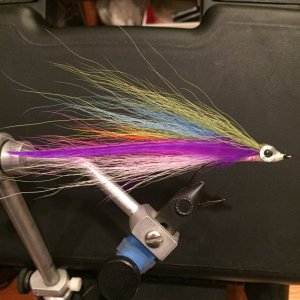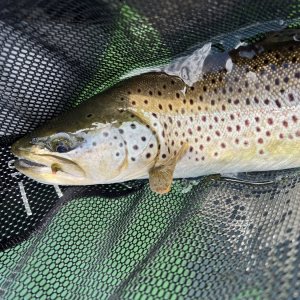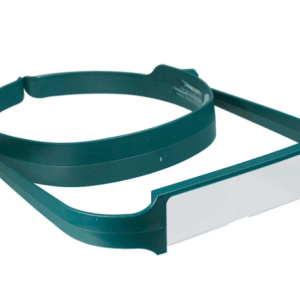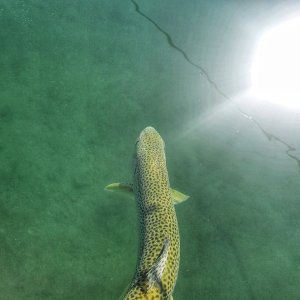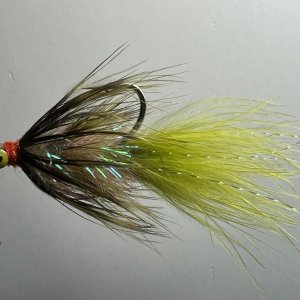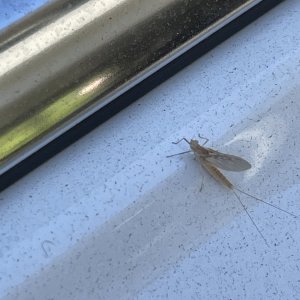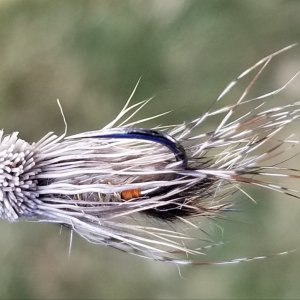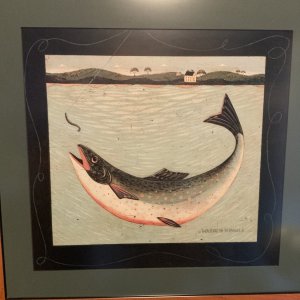Fishing the Last Mile First – Part II – Boats and Gear
Mike Cline, Bozeman, Montana
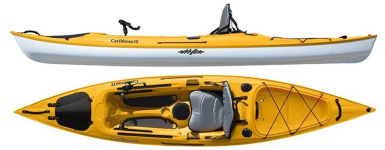
Eddyline 12' Caribbean 12 Angler Sit on Top Kayak (44#)
Although at this point is it obvious that some type of kayak is required to Fish the Last Mile First, canoes and maybe personal pontoons might work in some waters, the kayak is the boat of choice. But not just any kayak. There are several considerations when choosing a kayak for Fishing the Last Mile First. One is weight. The lighter the kayak is, the easier it is to deal with on and off the water. Ideal weight range is from 35-55 pounds. A 70 or 100 pound plus kayak would be difficult for a solo angler to handle in most typical Fishing the Last Mile First situations. Another is length. I’ve always found the 12’ kayaks to be the optimum length. Shorter kayaks are indeed more maneuverable but suffer from lack of storage. Longer kayaks are not as maneuverable and tend to weigh more. Plus, a lack of maneuverability can be a serious issue on swift, narrow stream sections. A third consideration is storage. A Fishing the Last Mile First kayak is essentially a large floating tackle box where you store additional rods, gear, etc. Too little or ill-conceived storage options can significantly impact the angling experience. A final consideration is kayak style. Sit-on-Top (SOT) and hybrid styles are optimum as they allow rapid, unencumbered entry and exiting of the kayak. Sit-inside (SIN) kayaks are ill suited for the Fishing the Last Mile First as entering and exiting them is challenging in swift water conditions and they usually have poor storage options. Pedal drive type kayaks or kayaks with rudders are dangerous in shallow swift waters as the propellers or fins may drag on the bottom and could cause the kayak to flip or capsize.
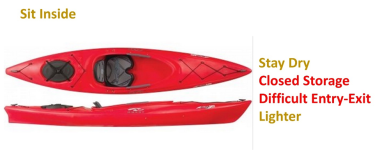
Typical Sit Inside Kayak
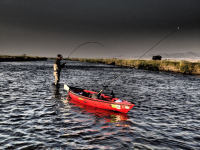
Angler with Tethered Kayak on Madison River
Once you have a kayak that you intend to use for Fishing the Last Mile First, the first step is to apply a strong, secure tether to the bow of the boat. I learned how to tether a kayak from the saltwater flats world where wading flats with kayak trailing behind you was a pretty common in the early 2000s. Tethers need to be constructed of high quality 520 paracord or equivalent in either ¼” or 5/16” diameters. The 5/16” is my preference as the larger diameter is more durable and the required knots don’t chinch up too tight. The configuration of the bow of the kayak determines how the tether is attached to the boat, but it should be attached with at least two points of contact. Merely tying a rope to the front handle of the kayak may seem convenient but invites wear and breakage. Tethers are connected to the angler with a large loop around the waist formed with three half hitches. The knots when wet slide easily. This allows the tether to be donned quickly and removed quickly if necessary. The length of the tether when around the angler’s waist should be at least one foot longer than the length of the boat. This allows the angler to reach the stern of the boat while attached to access gear stored there or dislodge the stern from an obstruction.
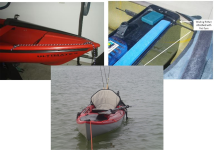
Left to Right: Kayak tethered along bow with two pad eyes, Kayak tethered from bow with three pad eyes, Kayak tethered in two places from gunnel brace
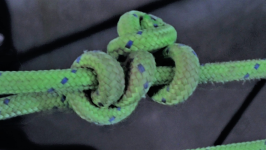
Tether loop created with three half-hitches, one opposing two parallel hitches
Obviously, a paddle is an essential aspect of the kayak game and plays an important role in Fishing the Last Mile First. There are two considerations when selecting a paddle—blade size and weight. There is a saying in the kayak world that goes something like this: “The last thing you will put down on the way back to the shore is the paddle.” Cheap paddles made with aluminum or steel shafts and heavy plastic blades weigh significantly more that high quality carbon fiber paddles. A heavy paddle can wear you out quickly if you have to paddle for extended periods. A lightweight paddle is far more forgiving. On the topic of paddle blade size. Whitewater kayakers use paddles with short, wide blades that will grab a lot of water quickly and provide powerful strokes. Sea kayakers use paddles with longer, narrower blades for subtle, shallow strokes to maintain direction and momentum. A Fishing the Last Mile First paddle doesn’t need the power that a whitewater paddler does, but the blade should be wide enough for the occasionally power strokes needed in swift water.
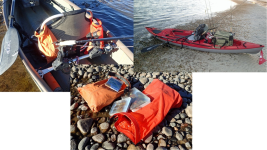
Assorted storage and other gear
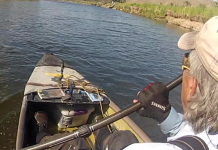
A good pair of fingerless gloves saves a lot of wear and tear on the hands.
There are a number of other gear items that are either essential or least very useful when Fishing the Last Mile First. One is a PFD—essential—whether you are wearing it or not. Another is a paddle tether. These are common in the kayak market. You never want your paddle to drift away because you didn’t tether it to the boat. Boat bags, rod holders, dry bags, fly patches, etc. are all useful items depending on the configuration of the kayak. This is a matter of opinion, but I much prefer wading unencumbered without any sort of vest or pack. With the exception of forceps, nippers and flotant and the occasional small fly box everything else is stored in the boat. Fingerless gloves, either for cold weather or sun gloves are a good idea as grit on your hands is inevitable from handling the tether. Paddling with gritty hands is uncomfortable.
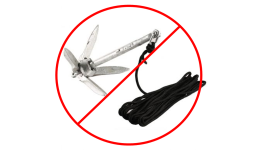
The one piece of gear you don’t want is an anchor. Trying to anchor a kayak in a swift river is a recipe for disaster. So, leaving the anchor home won't tempt you to try it. Once you’ve got a kayak geared up and ready to go, Fishing the Last Mile First is just a matter of following a few fundamentals. Fishing the Last Mile First – Part III -Fundamentals.
The Fishing the Last Mile First concept was first published in the Spring 2014 issue of Kayak Angler Magazine.
Fishing the Last Mile First – Part I – An Angling Strategy
Fishing the Last Mile First – Part II – Boats and Gear
Fishing the Last Mile First – Part III -Fundamentals
Fishing the Last Mile First – Part IV – Tips and Advice
Mike Cline, Bozeman, Montana

Eddyline 12' Caribbean 12 Angler Sit on Top Kayak (44#)
Although at this point is it obvious that some type of kayak is required to Fish the Last Mile First, canoes and maybe personal pontoons might work in some waters, the kayak is the boat of choice. But not just any kayak. There are several considerations when choosing a kayak for Fishing the Last Mile First. One is weight. The lighter the kayak is, the easier it is to deal with on and off the water. Ideal weight range is from 35-55 pounds. A 70 or 100 pound plus kayak would be difficult for a solo angler to handle in most typical Fishing the Last Mile First situations. Another is length. I’ve always found the 12’ kayaks to be the optimum length. Shorter kayaks are indeed more maneuverable but suffer from lack of storage. Longer kayaks are not as maneuverable and tend to weigh more. Plus, a lack of maneuverability can be a serious issue on swift, narrow stream sections. A third consideration is storage. A Fishing the Last Mile First kayak is essentially a large floating tackle box where you store additional rods, gear, etc. Too little or ill-conceived storage options can significantly impact the angling experience. A final consideration is kayak style. Sit-on-Top (SOT) and hybrid styles are optimum as they allow rapid, unencumbered entry and exiting of the kayak. Sit-inside (SIN) kayaks are ill suited for the Fishing the Last Mile First as entering and exiting them is challenging in swift water conditions and they usually have poor storage options. Pedal drive type kayaks or kayaks with rudders are dangerous in shallow swift waters as the propellers or fins may drag on the bottom and could cause the kayak to flip or capsize.

Typical Sit Inside Kayak

Angler with Tethered Kayak on Madison River
Once you have a kayak that you intend to use for Fishing the Last Mile First, the first step is to apply a strong, secure tether to the bow of the boat. I learned how to tether a kayak from the saltwater flats world where wading flats with kayak trailing behind you was a pretty common in the early 2000s. Tethers need to be constructed of high quality 520 paracord or equivalent in either ¼” or 5/16” diameters. The 5/16” is my preference as the larger diameter is more durable and the required knots don’t chinch up too tight. The configuration of the bow of the kayak determines how the tether is attached to the boat, but it should be attached with at least two points of contact. Merely tying a rope to the front handle of the kayak may seem convenient but invites wear and breakage. Tethers are connected to the angler with a large loop around the waist formed with three half hitches. The knots when wet slide easily. This allows the tether to be donned quickly and removed quickly if necessary. The length of the tether when around the angler’s waist should be at least one foot longer than the length of the boat. This allows the angler to reach the stern of the boat while attached to access gear stored there or dislodge the stern from an obstruction.

Left to Right: Kayak tethered along bow with two pad eyes, Kayak tethered from bow with three pad eyes, Kayak tethered in two places from gunnel brace

Tether loop created with three half-hitches, one opposing two parallel hitches
Obviously, a paddle is an essential aspect of the kayak game and plays an important role in Fishing the Last Mile First. There are two considerations when selecting a paddle—blade size and weight. There is a saying in the kayak world that goes something like this: “The last thing you will put down on the way back to the shore is the paddle.” Cheap paddles made with aluminum or steel shafts and heavy plastic blades weigh significantly more that high quality carbon fiber paddles. A heavy paddle can wear you out quickly if you have to paddle for extended periods. A lightweight paddle is far more forgiving. On the topic of paddle blade size. Whitewater kayakers use paddles with short, wide blades that will grab a lot of water quickly and provide powerful strokes. Sea kayakers use paddles with longer, narrower blades for subtle, shallow strokes to maintain direction and momentum. A Fishing the Last Mile First paddle doesn’t need the power that a whitewater paddler does, but the blade should be wide enough for the occasionally power strokes needed in swift water.

Assorted storage and other gear

A good pair of fingerless gloves saves a lot of wear and tear on the hands.
There are a number of other gear items that are either essential or least very useful when Fishing the Last Mile First. One is a PFD—essential—whether you are wearing it or not. Another is a paddle tether. These are common in the kayak market. You never want your paddle to drift away because you didn’t tether it to the boat. Boat bags, rod holders, dry bags, fly patches, etc. are all useful items depending on the configuration of the kayak. This is a matter of opinion, but I much prefer wading unencumbered without any sort of vest or pack. With the exception of forceps, nippers and flotant and the occasional small fly box everything else is stored in the boat. Fingerless gloves, either for cold weather or sun gloves are a good idea as grit on your hands is inevitable from handling the tether. Paddling with gritty hands is uncomfortable.

The one piece of gear you don’t want is an anchor. Trying to anchor a kayak in a swift river is a recipe for disaster. So, leaving the anchor home won't tempt you to try it. Once you’ve got a kayak geared up and ready to go, Fishing the Last Mile First is just a matter of following a few fundamentals. Fishing the Last Mile First – Part III -Fundamentals.
The Fishing the Last Mile First concept was first published in the Spring 2014 issue of Kayak Angler Magazine.
Fishing the Last Mile First – Part I – An Angling Strategy
Fishing the Last Mile First – Part II – Boats and Gear
Fishing the Last Mile First – Part III -Fundamentals
Fishing the Last Mile First – Part IV – Tips and Advice
Attachments
Last edited:


